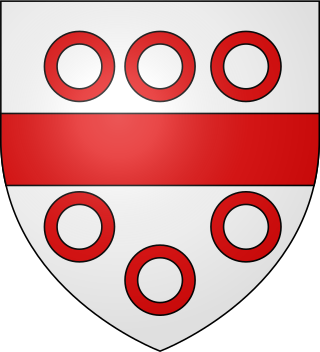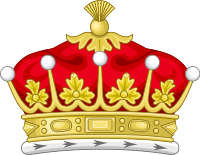
Viscount Cobham is a title in the Peerage of Great Britain that was created in 1718. Owing to its special remainder, the title has passed through several families. Since 1889, it has been held by members of the Lyttelton family.

Earl of Lincoln is a title that has been created eight times in the Peerage of England, most recently in 1572. The title was borne by the Dukes of Newcastle-under-Lyne from 1768 to 1988, until the dukedom became extinct.

Marquess Townshend is a title in the Peerage of Great Britain held by the Townshend family of Raynham Hall in Norfolk. The title was created in 1787 for George Townshend, 4th Viscount Townshend.

Earl of Coventry is a title that has been created twice in the Peerage of England. The first creation for the Villiers family was created in 1623 and took its name from the city of Coventry. It became extinct in 1687. A decade later, the second creation was for the Coventry family and is still extant.

Earl of Seafield is a title in the Peerage of Scotland. It was created in 1701 for James Ogilvie, who in 1711 succeeded his father as 4th Earl of Findlater. The earldoms of Findlater and Seafield continued to be united until 1811, when the earldom of Findlater became dormant, while the earldom of Seafield remains extant.

Baron FitzWalter is an ancient title in the Peerage of England. It was created on 24 June 1295 for Robert FitzWalter. The title was created by writ, which means that it can descend through both male and female lines.

Earl Cadogan is a title that has been created twice in the Peerage of Great Britain for the Cadogan family. The second creation, in 1800, was for Charles Cadogan, 3rd Baron Cadogan.

Baron Lucas is a title that has been created twice in the Peerage of England. The second creation is extant and is currently held with the title Lord Dingwall in the Peerage of Scotland.
Baron Darcy de Knayth is a title in the Peerage of England. It was created in 1332 for John Darcy with remainder to his heirs general, allowing daughters to inherit.

Baron Stafford, referring to the town of Stafford, is a title that has been created several times in the Peerage of England. In the 14th century, the barons of the first creation were made earls. Those of the fifth creation, in the 17th century, became first viscounts and then earls. Since 1913, the title has been held by the Fitzherbert family.

Earl of Craven, in the County of York, is a title that has been created twice, once in the Peerage of England and once in the Peerage of the United Kingdom.

Earl Kitchener, of Khartoum and of Broome in the County of Kent, was a title in the Peerage of the United Kingdom. It was created in 1914 for the famous officer Field Marshal Herbert Kitchener, 1st Viscount Kitchener of Khartoum. He had already been created Baron Kitchener of Khartoum, and of Aspall in the County of Suffolk, in 1898, Viscount Kitchener of Khartoum, and of the Vaal River in the Transvaal Colony, and of Aspall in the County of Suffolk, in 1902, and was made Baron Denton, of Denton in the County of Kent, and Viscount Broome, of Broome in the County of Kent, at the same time he was granted the earldom. These titles were also in the Peerage of the United Kingdom.

Earl of Strafford is a title that has been created three times in English and British history.

Viscount Grandison, of Limerick, is a title in the Peerage of Ireland. It was created in 1620 for Sir Oliver St John, the Lord Deputy of Ireland. He was the descendant and namesake of Oliver St John, whose elder brother Sir John St John was the ancestor of the Barons St John of Bletso and the Earls of Bolingbroke. Moreover, St John's nephew Sir John St John, 1st Baronet, of Lydiard Tregoze, was the ancestor of the Viscounts Bolingbroke and the Viscounts St John.
Earl Rivers was an English title, which has been created three times in the Peerage of England. It was held in succession by the families of Woodville, Darcy and Savage.

Marquess of Ripon, in the County of York, was a title in the Peerage of the United Kingdom. It was created in 1871 for the Liberal politician George Robinson, 2nd Earl of Ripon.

Marquess of Hastings was a title in the Peerage of the United Kingdom. It was created on 6 December 1816 for Francis Rawdon-Hastings, 2nd Earl of Moira.

Earl Coningsby was a title in the Peerage of Great Britain. It was created in 1719 for Thomas Coningsby, 1st Baron Coningsby, with remainder to his eldest daughter, Margaret Newton, 1st Viscountess Coningsby, and the heirs male of her body. He was the great-grandson of the soldier and politician Sir Thomas Coningsby. Coningsby had already been created Baron Coningsby, of Clanbrassil, in the Peerage of Ireland in 1693, with normal remainder to heirs male, and Baron Coningsby in the Peerage of Great Britain in 1716, with the similar remainder as for the earldom. On Lord Coningsby's death in 1729 he was succeeded in the Irish barony of 1692 by his grandson Richard Coningsby, the second Baron, the son of one of Coningsby's sons from his first marriage to Barbara Georges. However, Richard died already the same year, when the barony became extinct. Lord Coningsby was succeeded in the English barony and the earldom according to the special remainder by his daughter Margaret Newton, 1st Viscountess Coningsby. She had already in 1716 been made Baroness Coningsby, of Hampton Court in the County of Hereford, and Viscountess Coningsby in her own right. Both titles were in the Peerage of Great Britain. Lady Coningsby was the wife of Sir Michael Newton, 4th Baronet, of Barrs Court and Culverthorpe Hall, Lincolnshire. She had no surviving male issue and the titles became extinct on her death in 1761.

Baron Wentworth is a title in the Peerage of England. It was created in 1529 for Thomas Wentworth, who was also de jure sixth Baron le Despencer of the 1387 creation. The title was created by writ, which means that it can descend via female lines.

Earl Ligonier was a title that was created twice in British history, once in the Peerage of Great Britain and once in the Peerage of Ireland.










